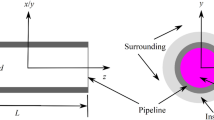Abstract
Algorithms of the optimal arrangement of heat sources with volumetric heat release within regions of a complex geometric shape are considered. The distribution found has the minimum total power and provides the temperature in the given temperature corridor. Finite-dimensional approximations of the original problem are constructed in the form of a linear programming problem. A method is given for constructing a finite-difference scheme for solving the heat equation, as well as a brief description of the developed software modules for constructing grids and solving equations. Several computer experiments have been carried out using the developed programs.







Similar content being viewed by others
REFERENCES
J.-L. Lions, Contrôle optimal de systèmes gouvernés par des équations aux dérivées partielles (Dunod, Paris, 1968).
S. Yu. Mirskaia and V. I. Sidelnikov, “Efficient heating of the room as the optimal control problem,” Tekh.-Tekhnol. Probl. Servisa, No. 4 (30), 75–78 (2014).
A. V. Akhmetzianov and V. N. Kulibanov, “Optimal source placement for stationary scalar fields,” Avtom. Telemekh., No. 6, 50–58 (1999).
R. P. Fedorenko, An Approximate Solution to Optimal Control Problems (Nauka, Moscow, 1978) [in Russian].
A. G. Butkovskii, Theory of Optimal Control of Systems with Distributed Parameters (Nauka, Moscow, 1965) [in Russian].
D. Tabak and V. S. Kuo, Optimal Control and Mathematical Programming (Prentice Hall, NJ, 1971).
O. M. Alifanov, Inverse Heat Transfer Problems (Springer, Berlin, New York, 1994; Mashinostroenie, Moscow, 1988).
K. O. Sabdenov and T. M. Baitasov, “Optimal (energy efficient) heat supply to buildings in central heating system,” Izv. Tomsk. Politekh. Univ., Inzhin. Georesur. 326 (8), 53–60 (2015).
A. G. Brusentsev and O. V. Osipov, “Approximate solution of the optimal choice problem of heat sources,” Nauch. Vedom. Belgor. Univ., No. 5 (124), Iss. 26, 60–69 (2012).
O. V. Osipov, “Optimal location of heat sources in a non-heterogeneous environment,” Vestn. Belgor. Tekhnol. Univ. Shukhova, No. 1, 154–158 (2013).
A. G. Brusentsev and O. V. Osipov, “Optimal selection of heat sources in the presence of convection,” Nauch. Vedom. BelGU, Mat. Fiz., No. 26 (169), Iss. 33, 64–82 (2013).
P. N. Vabishchevich and A. A. Samarskii, “Finite-difference schemes for convection–diffusion problems on irregular meshes,” Comput. Math. Math. Phys. 40, 692 (2000).
G. R. Shangareeva and S. A. Mustafina, “Parallelizing the conjugate gradient method using Nvidia CUDA technology,” Nauch. Vestn., No. 2 (2), 154–161 (2014).
A. Yu. Chernyshenko, “Generation of octree meshes with cut cells in multiple material domains,” Vychisl. Metody Programmir. 14, 229–245 (2013).
Funding
The article was prepared as part of a core university development program based on the Shukhov Belgorod State Technological University.
Author information
Authors and Affiliations
Corresponding authors
Ethics declarations
The authors declare that they have no conflict of interest.
Rights and permissions
About this article
Cite this article
Osipov, O.V., Brusentsev, A.G. Optimal Location of Heat Sources Inside Areas with Complex Geometric Shapes. Math Models Comput Simul 11, 905–913 (2019). https://doi.org/10.1134/S2070048219060152
Received:
Revised:
Accepted:
Published:
Issue Date:
DOI: https://doi.org/10.1134/S2070048219060152




